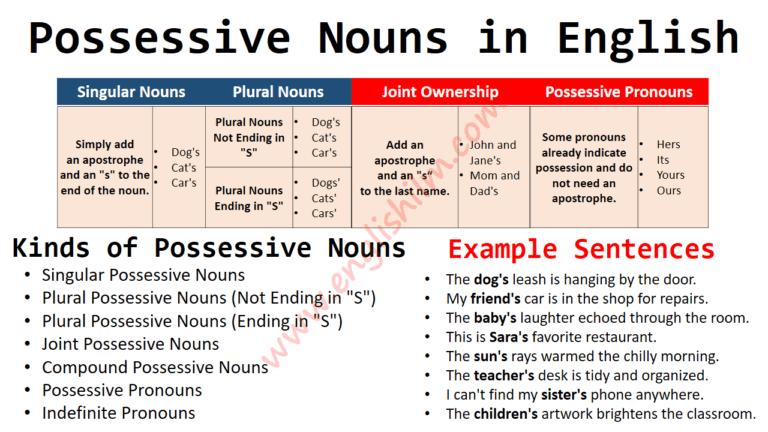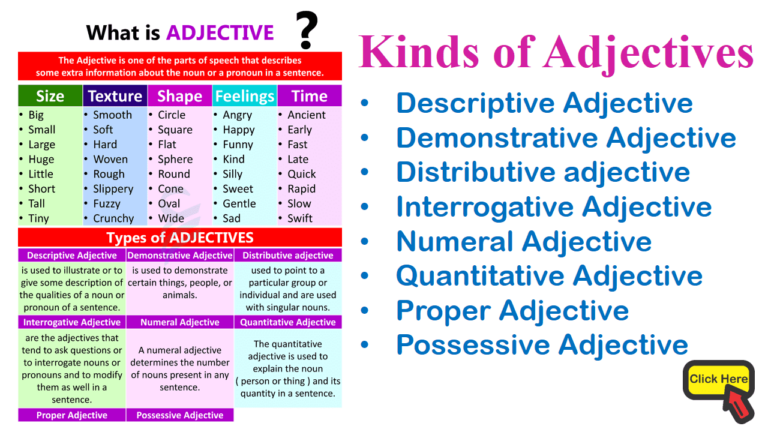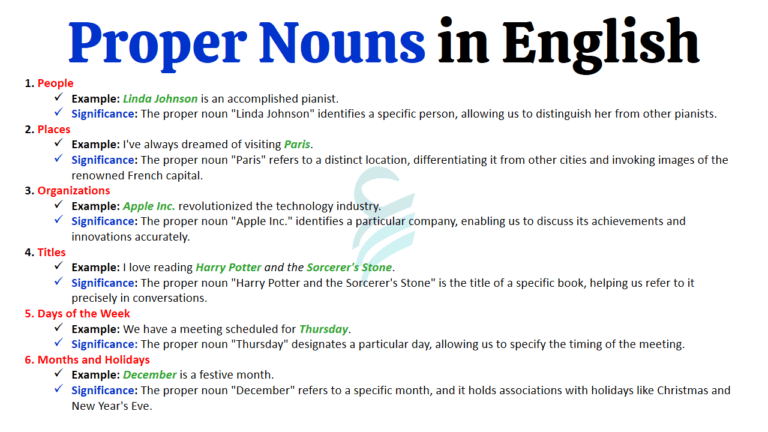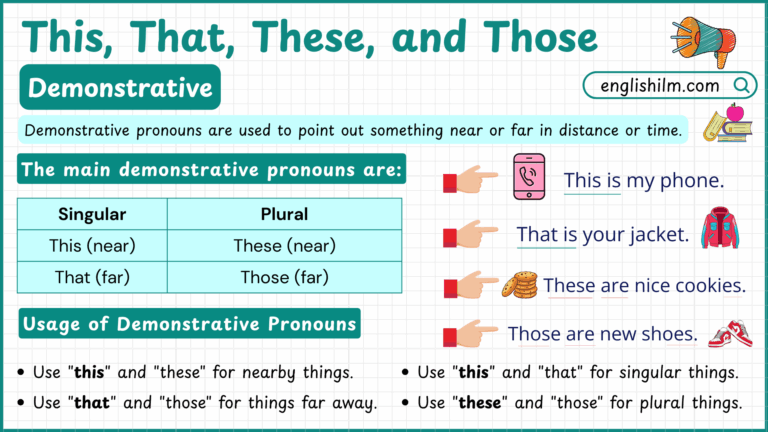Understanding singular and plural nouns is essential for clear and effective communication in English. Singular nouns refer to one person, place, or thing, while plural nouns indicate more than one. Learning the rules for forming plurals, along with common exceptions, helps improve both writing and speaking skills. In this blog post, we will explore rules, examples, and common mistakes related to singular and plural nouns.
Improve your grammar skills with more lessons in our Grammar category.
Definition of Singular Nouns
Singular nouns refer to a single item, person, place, or concept. They are the opposite of plural nouns, which refer to more than one.
Rules for Singular Nouns:
- Add -s: In many cases, you can form the singular form of a noun by adding -s to the plural form. For example:
- Singular: car, Plural: cars
- Singular: book, Plural: books
- No Change: Some nouns have the same form in both singular and plural. For example:
- Singular and Plural: deer, sheep, fish
- Change the Vowel or Add -es: Certain nouns ending in -o may require the addition of -es to form the singular (e.g., tomatoes, potatoes). Some nouns ending in -y preceded by a consonant change the -y to -ies (e.g., city, cities).
- Irregular Forms: Some nouns have irregular forms in the plural. For example:
- Singular: man, Plural: men
- Singular: child, Plural: children
Also learn: 12 Kinds of Nouns in English
Examples of Singular Nouns
- cat, dog, house, computer, idea, book, chair, city, person, car, etc.
Common Mistakes to Avoid
- Misuse of Plural Forms: Ensure that you’re using the singular form when referring to a single item or entity. For example, “I have two cats” (plural) vs. “The cat is on the table” (singular).
- Confusing Possessive Forms: Understand the difference between singular possessive (e.g., the cat’s tail) and plural possessive (e.g., the cats’ tails).
- Overlooking Irregular Forms: Be aware of irregular plural forms, especially for common nouns like man/men, woman/women, child/children, etc.
- Subject-Verb Agreement: Ensure that the verb agrees with the singular noun in the sentence. For example, “The cat is” (singular) vs. “The cats are” (plural).
- Countable vs. Uncountable Nouns: Understand whether a noun is countable or uncountable, as this affects the use of singular or plural forms. For example, “water” is uncountable, so it is always singular.
Plural Nouns
Plural nouns refer to more than one person, place, thing, or idea. They are the opposite of singular nouns, which denote a single entity.
Rules for Plural Nouns
- Add -s: The most common way to form plural nouns is by adding -s to the singular form. For example:
- Singular: car, Plural: cars
- Singular: book, Plural: books
- Change -y to -ies: If a noun ends in -y preceded by a consonant, change -y to -ies to form the plural. For example:
- Singular: city, Plural: cities
- Singular: baby, Plural: babies
- Add -es: Nouns ending in -s, -x, -z, -ch, or -sh generally add -es to form the plural. For example:
- Singular: box, Plural: boxes
- Singular: church, Plural: churches
- Change -f or -fe to -ves: If a noun ends in -f or -fe, change -f or -fe to -ves to form the plural. For example:
- Singular: leaf, Plural: leaves
- Singular: knife, Plural: knives
- Irregular Forms: Some nouns have irregular plural forms. For example:
- Singular: mouse, Plural: mice
- Singular: tooth, Plural: teeth
Examples of Plural Nouns
- cats, dogs, houses, computers, ideas, books, chairs, cities, people, cars, etc.
Common Mistakes to Avoid
- Using Singular Form Incorrectly: Ensure that you use the plural form when referring to more than one item or entity. For example, “The cat is on the table” (singular) vs. “The cats are on the table” (plural).
- Overlooking Irregular Forms: Be aware of irregular plural forms, especially for common nouns like mouse/mice, tooth/teeth, man/men, etc.
- Subject-Verb Agreement: Ensure that the verb agrees with the plural noun in the sentence. For example, “The cat is” (singular) vs. “The cats are” (plural).
- Countable vs. Uncountable Nouns: Understand whether a noun is countable or uncountable, as this affects the use of singular or plural forms. For example, “water” is uncountable, so it is always singular.
Also learn: Human Body Parts with Images
Special Rules to Form Plural Nouns
In addition to the general rules for forming plural nouns, there are some special cases and exceptions that you should be aware of:
- Nouns Ending in -s, -x, -z, -sh, -ch:
- Add -es to nouns ending in -s, -x, -z, -sh, or -ch.
- Singular: bus, Plural: buses
- Singular: box, Plural: boxes
- Singular: buzz, Plural: buzzes
- Singular: dish, Plural: dishes
- Singular: church, Plural: churches
- Add -es to nouns ending in -s, -x, -z, -sh, or -ch.
- Nouns Ending in -y preceded by a Vowel:
- Simply add -s to nouns ending in -y preceded by a vowel.
- Singular: toy, Plural: toys
- Singular: boy, Plural: boys
- Simply add -s to nouns ending in -y preceded by a vowel.
- Nouns Ending in -o:
- Add -s to most nouns ending in -o. However, there are exceptions where you need to add -es.
- Singular: tomato, Plural: tomatoes
- Singular: hero, Plural: heroes
- Singular: piano, Plural: pianos
- Singular: photo, Plural: photos
- Add -s to most nouns ending in -o. However, there are exceptions where you need to add -es.
- Nouns Ending in -f or -fe:
- Change -f or -fe to -ves to form the plural.
- Singular: leaf, Plural: leaves
- Singular: knife, Plural: knives
- Singular: half, Plural: halves
- Change -f or -fe to -ves to form the plural.
- Irregular Plural Forms:
- Some nouns have irregular plural forms that do not follow the standard rules.
- Singular: mouse, Plural: mice
- Singular: tooth, Plural: teeth
- Singular: man, Plural: men
- Some nouns have irregular plural forms that do not follow the standard rules.
- Compound Nouns:
- For compound nouns, make the most significant word plural.
- Singular: passerby, Plural: passersby
- Singular: mother-in-law, Plural: mothers-in-law
- For compound nouns, make the most significant word plural.
- Nouns Ending in -us:
- Change -us to -i for the plural form.
- Singular: cactus, Plural: cacti
- Singular: focus, Plural: foci
- Change -us to -i for the plural form.
- Nouns Ending in -is:
- Change -is to -es for the plural form.
- Singular: thesis, Plural: theses
- Singular: basis, Plural: bases
- Change -is to -es for the plural form.
- Nouns with the Same Singular and Plural Form:
- Some nouns have the same form in both singular and plural.
- Singular and Plural: deer, sheep, fish
- Some nouns have the same form in both singular and plural.
General Rules to Form Plural Nouns
Most singular nouns are made plural by adding -s to the end of the singular form.
Singular and Plural Nouns Examples:
- car – cars
- bag – bags
- table – tables
- house – houses
- dog – dogs
Also learn: Countable Nouns Rules, Usage, and Examples
Plural Noun Rules for Irregular Nouns
Irregular plural nouns do not follow the standard rules for forming plurals in English. Instead, they have unique and often unpredictable changes in spelling. Here are some common patterns for irregular plural nouns:
- Change -man to -men:
- Singular: man, Plural: men
- Singular: woman, Plural: women
- Change -child to -children:
- Singular: child, Plural: children
- Change -ox to -oxen:
- Singular: ox, Plural: oxen
- Change -goose to -geese:
- Singular: goose, Plural: geese
- Change -mouse to -mice:
- Singular: mouse, Plural: mice
- Change -tooth to -teeth:
- Singular: tooth, Plural: teeth
- Change -foot to -feet:
- Singular: foot, Plural: feet
- Change -louse to -lice:
- Singular: louse, Plural: lice
- Change -man to -men:
- Singular: man, Plural: men
- Change -woman to -women:
- Singular: woman, Plural: women
- Change -die to -dice:
- Singular: die, Plural: dice
- Keep the Same Form:
- Some nouns have the same form in both singular and plural.
- Singular and Plural: deer, sheep, fish
- Some nouns have the same form in both singular and plural.
- Change -is to -es:
- Singular: crisis, Plural: crises
- Singular: analysis, Plural: analyses
- Change -us to -i:
- Singular: focus, Plural: foci
- Singular: cactus, Plural: cacti
- Keep Foreign Plural Forms:
- Some foreign words maintain their original plural forms in English.
- Singular: curriculum, Plural: curricula
- Singular: phenomenon, Plural: phenomena
- Some foreign words maintain their original plural forms in English.
Also learn: Noun Definition, Kinds Of Noun
Singular and Plural Nouns Images


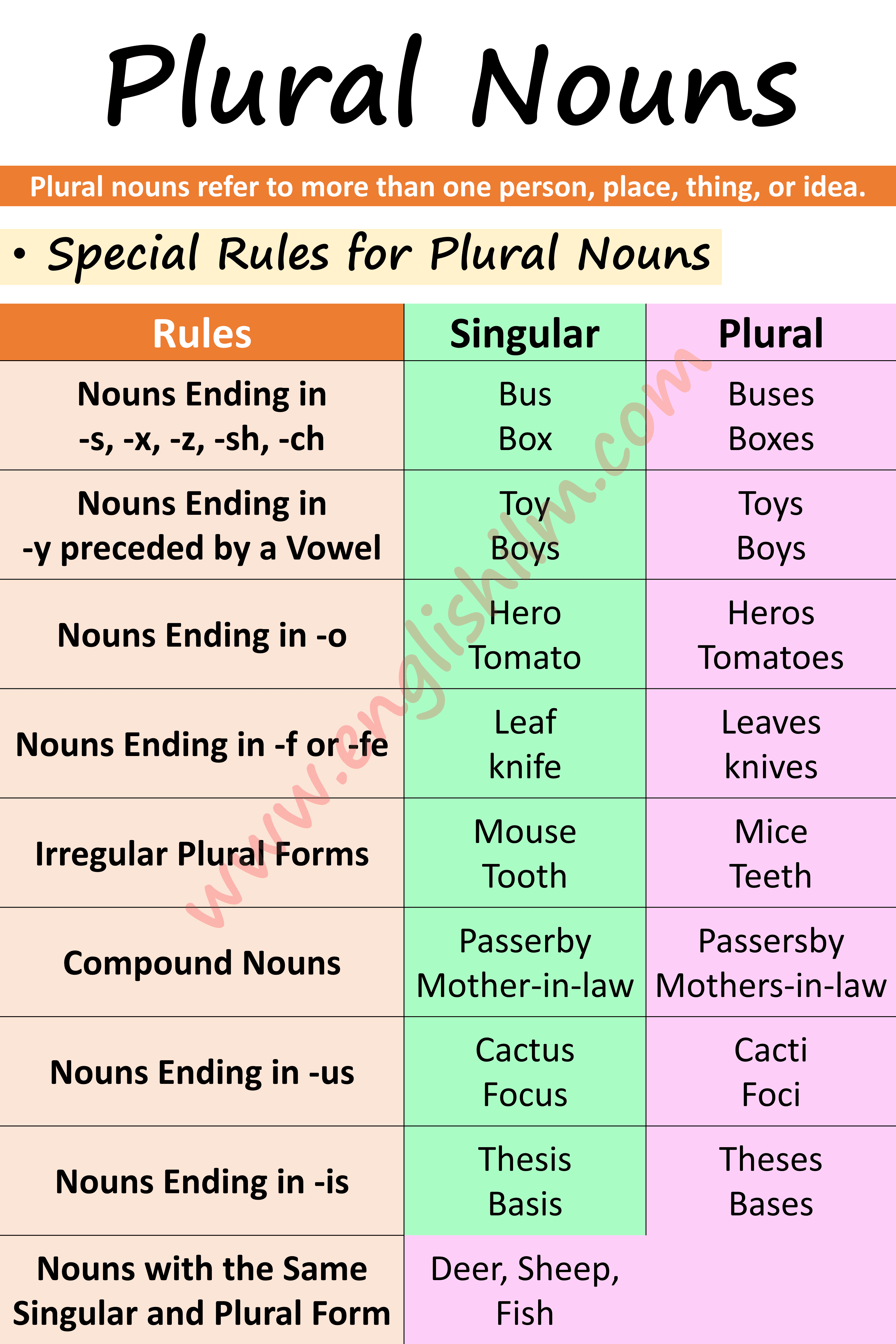
You may also like:


